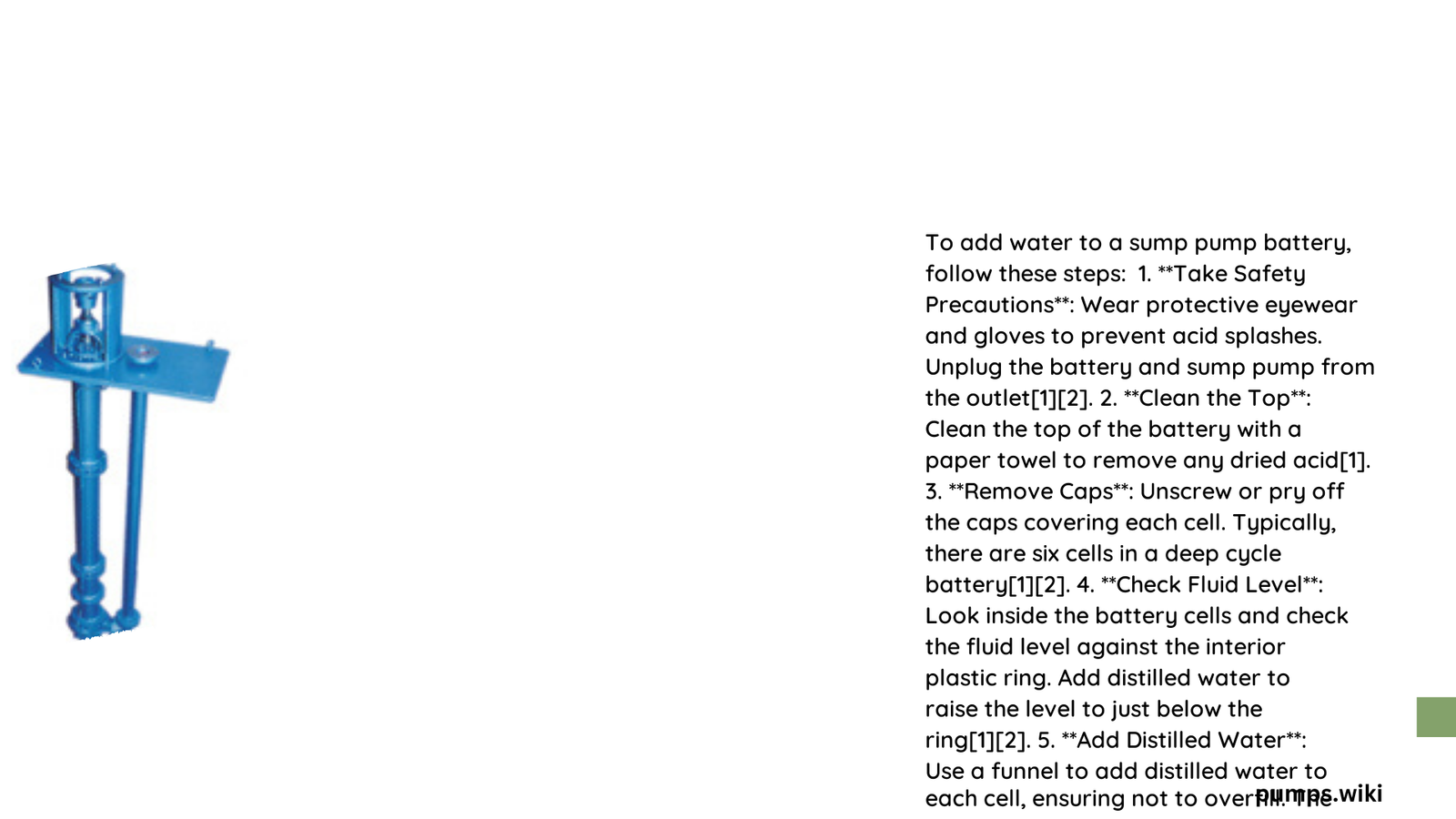Adding water to a sump pump battery is a crucial maintenance task that ensures optimal performance and longevity of your backup system. This process involves carefully monitoring fluid levels, using the right type of water, and following specific procedures to avoid damage. Regular maintenance of sump pump batteries, including proper water addition, can prevent system failures during critical times and save homeowners from costly repairs or replacements.
What Are the Specific Water Level Requirements for Sump Pump Batteries?
Maintaining the correct water level in sump pump batteries is essential for their proper functioning and longevity. Here are the key requirements:
- The optimal fluid level should be just below the lower end of the interior plastic ring or cap ring inside each cell.
- Fill each cell to a level that just covers the battery plates.
- Ensure all cells are filled equally to maintain balanced performance.
How to Measure Fluid Levels Accurately?
To accurately assess the fluid levels in your sump pump battery:
- Look inside the openings of each cell.
- Check the fluid level against the plastic ring extending down inside each cell.
- Ensure fluid levels are equal across all cells.
What Tools and Materials Are Needed to Add Water to a Sump Pump Battery?

Before you begin the process of adding water to your sump pump battery, gather the following items:
- Protective eyewear
- Rubber gloves
- Distilled water
- Pliers or a slotted screwdriver (for removing caps)
- Paper towels (for cleaning)
What Is the Step-by-Step Procedure for Adding Water to a Sump Pump Battery?
Follow these steps to safely and effectively add water to your sump pump battery:
- Safety First: Put on protective eyewear and rubber gloves.
- Power Down: Unplug the battery from the outlet to remove all electrical power.
- Clean the Battery: Wipe the top of the battery with a paper towel to remove any dried acid.
- Remove Caps: Take off the battery caps using pliers or a slotted screwdriver if necessary.
- Check Levels: Inspect the fluid level in each cell against the interior plastic ring.
- Add Distilled Water: Carefully add distilled water to raise the fluid level to just below the cap ring.
- Replace Caps and Wires: Once water is added, replace the caps and ensure all connections are secure.
- Power Up: Plug the sump pump and battery pack back into the outlet.
- Verify Operation: Ensure the system is functioning properly after maintenance.
How Often Should Sump Pump Battery Water Levels Be Checked?
Regular maintenance is key to ensuring your sump pump battery remains in good condition. Here’s a recommended schedule:
- Check battery water levels every six months
- Clean battery terminals twice a year
What Are the Signs That Water Needs to Be Added?
Be alert for these indicators that your sump pump battery requires water:
- A red light or alarm on the battery backup system
- Visible low fluid levels when checking against the interior plastic ring
What Are the Consequences of Improper Water Levels in Sump Pump Batteries?
Maintaining proper water levels is crucial for battery health and performance. Here’s what can happen if levels are incorrect:
| Water Level | Consequences |
|---|---|
| Too Low | – Reduced battery performance – Shortened lifespan – Overheating – Exposed and damaged plates |
| Too High | – Acid spillage – Corrosion – Potential damage to surrounding areas |
How Does Improper Maintenance Affect Costs?
Neglecting proper maintenance of your sump pump battery can lead to:
- More frequent battery replacements (typically needed every five years)
- Premature failure of the sump pump system
- Increased overall maintenance and replacement costs
What Type of Water Should Be Used in Sump Pump Batteries?
Using the correct type of water is crucial for the health and longevity of your sump pump battery:
- Always use distilled water
- Avoid tap water, which contains minerals harmful to batteries
- Never use bottled or filtered water, as these may still contain impurities
How Can Overfilling Be Avoided When Adding Water to Sump Pump Batteries?
To prevent overfilling and potential damage:
- Add water slowly and carefully
- Use a funnel to control the flow
- Stop filling when the water level reaches just below the cap ring
- Check levels frequently during the filling process
What Safety Precautions Should Be Taken When Handling Sump Pump Batteries?
Safety should always be a priority when working with batteries:
- Wear protective eyewear and rubber gloves
- Work in a well-ventilated area
- Keep sparks and flames away from the battery
- Have baking soda on hand to neutralize any acid spills
- Wash hands thoroughly after handling the battery
By following these guidelines and maintaining proper water levels, you can ensure your sump pump battery remains in optimal condition, ready to protect your home when needed.
References:
1. How to Add Water to a Battery – Happy Haute Home
2. How to Add Distilled Water to Sump Pump Batteries – Hunker
3. Battery Filling Instructions – Basement Watchdog
